Stone, minerals and semiprecious of the world stone
Oxide and hydrooxide: Corundum -->rus
 Diagnostic cart.
Diagnostic cart.
Al2 O3
Crystal structure trigonal
Hardness on the Mohs scale 9
Specific unit weight mass 3,95-4,1
Cleavage pseudocleavage on a double
Fracture, break padman
Colors colourless, multicolors
Colors in powder triturate white
Glance (glitter, glare) as diamond
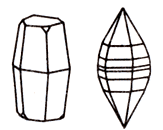
On hardness Corundums yields only to the diamond, though in 140 times more soft than him. At the same time Corundum in 7 times harder than topaz - next standard mineral of Mohs hardness. Thus hardness of ruby distinctly changes depending on direction in a crystal, that must be taken into account in the process of cutting. High hardness of corundum allows to use his not jeweller varieties as an abrasive. Corundum serves as main component part of emery glass-dust.
Corundum is a white, grey, blue, green, red, yellow, or brown mineral, found in metamorphosed shales and limestones, in veins, and in some igneous rocks. It is used as an abrasive and as gemstone; the red variety is ruby, the blue is sapphire. Composition: aluminium oxide. Formula: Al2O3. Crystal structure: hexagonal (rhombohedral) Etymology: from Tamil kuruntam; related to Sanskrit kuruvinda - ruby.
Corundum, occupying on hardness the second place and yielding in that behalf only to the diamond, is widely known. His crystals mostly bipyramidal and prismatic-bipyramidal. Short prisms, endings with a wide pinacoid, give crystals a discal type. A mineral forms difficult polysynthetic twins. Such double is with a naked eye recognized hardly.
 On a photo: Prismatic crystals of red corundum (ruby, North Maysur, India). Down. Crystals of corundum of bipyramidal type, characteristic for this mineral.
On a photo: Prismatic crystals of red corundum (ruby, North Maysur, India). Down. Crystals of corundum of bipyramidal type, characteristic for this mineral.
If a double is visible, it is possible to look over the great number of intense of the located plates, having a clear geometrical orientation. Corundum has the allochroic colouring: if it is deprived admixtures, quite colourless, but if there is a lot of other elements in him, becomes painted. Among varieties it is necessary to mention garmofane (grey and opaque); east Amethyst (padparadgahe - orange), ruby (red); blue Sapphire, emery - grainy Corundum, mixed with the oxides of iron. Presence of the shallow including, oriented the special appearance, condition phenomenon of asterism (star-shaped, stellar, stellate Corundum).
Chemical composition (chemistry, compound)-maintenance (in %): Al- 53,2; About - 48,8; the insignificant admixtures of chrome, iron, manganese, titan are marked. Trigonal-skalenoedrical type of symmetry. Be found as crystals of barrel-shaped dolioform, dipyramid, bipyramid, prismatic, lamellar tabular type. Main simple forms: (0001), (1010), (1120), (1011), (2241), (2243) and other Often there are polysynthetic twins to on (1011) and (0001). Crystals in are many cases deformed. Verge of prisms, dipyramids and pinacoid covered the slanting shading. A horizontal separateness and shading is sometimes marked because of double on pinacoidal. Cleavage - non-existent (pseudocrystal).
Diagnostic indication.
Many Corundums with lightness divided into plates along some planes. But it the phenomenon is real not cleavage, but special phenomenon, urgent pseudocleavage. It is conditioned a polysynthetic double as plates. Corundum - unique mineral with hardness 9. It can be scratched slightly only by a diamond. Many standards of corundum are able fluoresce in ultraviolet rays (ultraviolet radiation, UV radiation).
Origin provenance genesis.
Corundum - mineral of metamorphic rocks. It be found also in rocks, formings of deep magma, rich in a silica.
Deposit minefield mine field occurrence subsoil.
The large crystals of this mineral are found in ancient rocks on Ural, in Canada, United States and on Madagascar. Corundum of perfect jeweller quality is obtained in Burma, Thailand, Cambodia, Sri Lanka, Australia, in Montana (USA). An emery is obtained in Turkey and on an island Naksos in Greece.
Use, practical application, deployment.
Due to the hardness Corundum is used as an abrasive; but now it is all anymore replaced by artificial synthetic materials. Used on sentinel business and exact instrument-making for making of bearings and shell. From him also get an aluminium. Presently on jeweller business of Corundum used rarely enough - for these aims it already is more than century made artificial synthetic.
Surplus of aluminium in an organism (arises up at the production of synthetic corundums, rubies and Sapphires - at the operators of production options) reduces сопротивляемость to the infections, causes anaemia, can be nervous poison - paralyses a cns and heart, causes shaking of head and cramp (nervous break-downs - actively strikes nerves, directly going out from a cerebrum). Causes the "hallucinations of electrician" - black spots dark-and-light (to 10 шт.) and defects (displacements) of color of image. An aluminium is braked by mastering of many biotelements and vitamins (calcium, magnesium, iron, vitamin of V6, ascorbic acid) and sulfur-containing amino acid (lose weight).
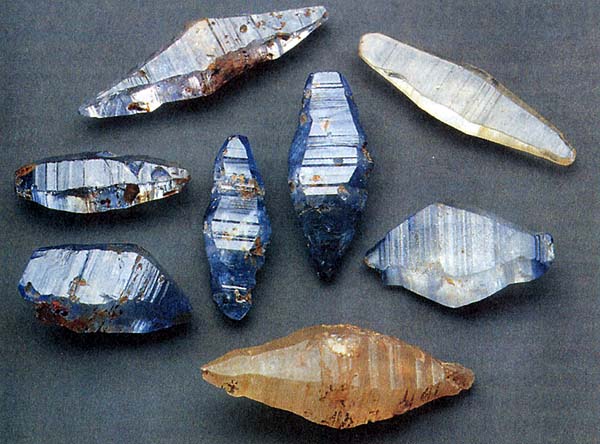
Use is on jeweller business. jewellers. Ruby is a red variety with the admixture of chrome. It is obtained from dolomite granular limestone, marble and alluvial mineral deposits. Acts mainly from north Burma, Thailand, Sri Lanka and Tanzania. Transparent rubies are always small: find of stone in a 10 carat is rareness. Extraordinary copies are widely known - it "Rosser-rivz-rubi" in a 140 carat (Smitsonovskiy institute, Washington) and "Long-star-rubi" (Museum of natural science, New York), being a star-shaped, stellar, stellate ruby in a 100 carat. Transparent rubies are exposed to cutting exceptionally by fasings; for translucent preferably form of cabochons. Entail befits for very large copies (cut in engraving). In strict sense the term of "Sapphire" is applicable only to the blue variety of corundum; but enough often so all of Corundums designate, whose color differs from red.
Sapphire obtain mainly from placer deposit mine - alluvial deposits. Main places of booty are Australia, Sri Lanka, Burma and Thailand. Sapphires of exceptional sizes is "Star of India" in 563 carats (Museum of natural science, New York) and "Star of Asia" in a 330 carat (Smitsonovskiy institute, Washington). Most widespread cutting for transparent Sapphire - oval or round with fasings; but there is also cutting as a heart, shuttle and forepart - baguette.
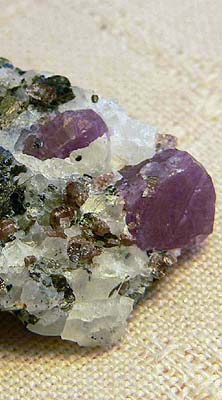
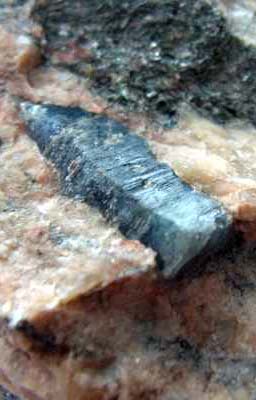

Corundum: Ruby
A ruby got the name for a red color (lat. Ruber - red). Only in 1800 it was set that a ruby and Sapphire are the varieties of corundum. To it it was named a ruby and red Spinel, and Garnet (all of three minerals named also carbuncles). A chrome serves as main chromophore in a ruby, brownish tints are given by iron. Colors of rubies varies both on different deposits and within the limits of one deposit, therefore judging on the tint of ruby about the place of his origin is impossible.
Such names, as "burmese" or "Siamese" ruby, only enter in an error and serve, rather, by the high-quality estimation of stone. The rubies of "color of dove-like blood" are most valued - cleanly-red with an easy purple tint. Colouring is often distributed unevenly: by spots or bars. Untilled stone have dim or fatty brilliance, but the cut ruby sparkles almost as a diamond.
Although cleavage at a ruby is not present, but on certain directions is a separateness is well expressed. Fragility and fracturing of natural ruby is predetermined by the careful handling him at cutting and insertion of stone in a frame (unlike the artificial synthetic reared rubies which durable enough). Often meet in the rubies of inclusion. However much they ignore the defects of stone, and vice versa - testify to their natural origin. Character of including (minerals, ductings or other cavities) can serve as pointing on the deposit of ruby. Including of needles of rutile give a stone either a tender silky ebb or - at the proper polishing cabochons is an effect of cat's-eye or exposes the highly valued asterism - figure of the Hexacorallia star, sliding on the surface of cabochons at his turn very much.
Corundum: Sapphire
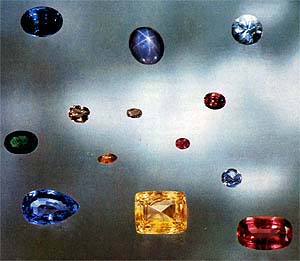 Pleochroism: at dark blue Sapphire distinct - from dark- to greenish-yellow and yellow; at yellow weak - from greenish-yellow to yellow; at green weak - from yellow-green to green; at violet distinct - from violet to rose. Sapphires in antiquity named the most different dark blue stone - from Sapphire to Lazurite. At the beginning of XIX century revealed, that Sapphire and ruby were jeweller varieties of corundum.
Pleochroism: at dark blue Sapphire distinct - from dark- to greenish-yellow and yellow; at yellow weak - from greenish-yellow to yellow; at green weak - from yellow-green to green; at violet distinct - from violet to rose. Sapphires in antiquity named the most different dark blue stone - from Sapphire to Lazurite. At the beginning of XIX century revealed, that Sapphire and ruby were jeweller varieties of corundum.
In the beginning Sapphire was named only dark blue variety, to the transparent corundums of other flowers, except for red, the special appropriated, especially point-of-sale names: for example, green Corundum named east peridotite or east emerald, yellow, gold - by east topaz et cetera Such the names quite often were misled. Today jeweller Corundums of any color understand under the name "Sapphire", except for red, - ruby. Colors Sapphire it is now accepted to specify specially. For example: green or yellow, gold Sapphire. If talked simply "Sapphire" - speech goes only about a dark blue stone. Colourless Sapphire name also leuko-sapphire, orange-yellow, gold - padparage (Singhalese is a "flower of lotus").
A sharp border does not exist between Sapphires of rose-violet tones and ruby. Light red, rose and violet Corundums usually attribute to the sapphires: in fact among Sapphires they are quoted enough highly, but as rubies would consider them low-grade. Iron and titan serve as хромофором in a dark blue sapphire, in violet is vanadium. The insignificant admixture of trivalent iron gives a sapphire yellow, and bivalent - green colouring. Rose tints are conditioned the admixture of chrome. Blue-dark blue Sapphires of clean water is most valued.
Hardness on the Mohs scale at Sapphire so high, as well as at a ruby, and in the same measure depends on direction in a crystal. It is important to take into account the anisotropy of hardness at cutting. Some single colouring of luminescence, characteristic for all of Sapphires, does not exist - its color depends on the own color of stone and from a deposit. Including of needles of rutile stipulate silky brilliance of stone, in great numbers is an effect of "cat's-eye" and Hexacorallia star: star-shaped, stellar, stellate Sapphire. In opinion of some researchers, the high-valued and rare asterism of Sapphire unlike a ruby is caused the not needles of rutile, but hollow ductings, oriented in three directions.
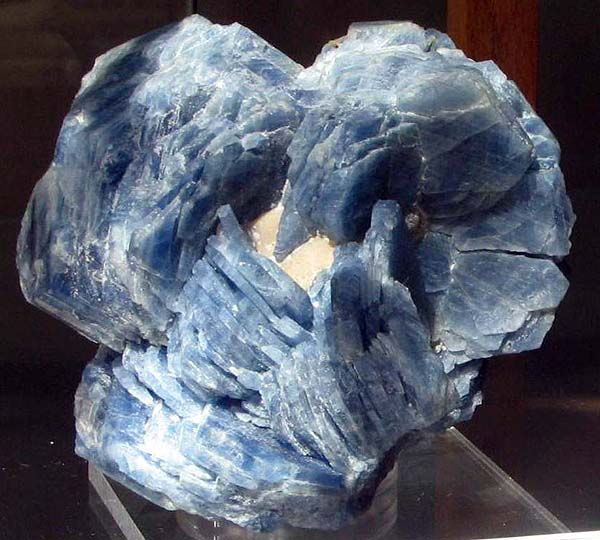
Corundum. Join of the split crystals ("rose"). Size 11 sm Il'menskie of mountain. Ural. A photo: © A.A. Evseev.
